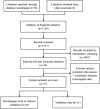A pooled analysis of the risk prediction models for mortality in acute exacerbation of chronic obstructive pulmonary disease
- PMID: 36945821
- PMCID: PMC10435958
- DOI: 10.1111/crj.13606
A pooled analysis of the risk prediction models for mortality in acute exacerbation of chronic obstructive pulmonary disease
Abstract
Objective: The prognosis for acute exacerbation of chronic obstructive pulmonary disease (AECOPD) is not optimistic, and severe AECOPD leads to an increased risk of mortality. Prediction models help distinguish between high- and low-risk groups. At present, many prediction models have been established and validated, which need to be systematically reviewed to screen out more suitable models that can be used in the clinic and provide evidence for future research.
Methods: We searched PubMed, EMBASE, Cochrane Library and Web of Science databases for studies on risk models for AECOPD mortality from their inception to 10 April 2022. The risk of bias was assessed using the prediction model risk of bias assessment tool (PROBAST). Stata software (version 16) was used to synthesize the C-statistics for each model.
Results: A total of 37 studies were included. The development of risk prediction models for mortality in patients with AECOPD was described in 26 articles, in which the most common predictors were age (n = 17), dyspnea grade (n = 11), altered mental status (n = 8), pneumonia (n = 6) and blood urea nitrogen (BUN, n = 6). The remaining 11 articles only externally validated existing models. All 37 studies were evaluated at a high risk of bias using PROBAST. We performed a meta-analysis of five models included in 15 studies. DECAF (dyspnoea, eosinopenia, consolidation, acidemia and atrial fibrillation) performed well in predicting in-hospital death [C-statistic = 0.91, 95% confidence interval (CI): 0.83, 0.98] and 90-day death [C-statistic = 0.76, 95% CI: 0.69, 0.82] and CURB-65 (confusion, urea, respiratory rate, blood pressure and age) performed well in predicting 30-day death [C-statistic = 0.74, 95% CI: 0.70, 0.77].
Conclusions: This study provides information on the characteristics, performance and risk of bias of a risk model for AECOPD mortality. This pooled analysis of the present study suggests that the DECAF performs well in predicting in-hospital and 90-day deaths. Yet, external validation in different populations is still needed to prove this performance.
Keywords: AECOPD; mortality; pooled analysis; prediction models.
© 2023 The Authors. The Clinical Respiratory Journal published by John Wiley & Sons Ltd.
Conflict of interest statement
The authors declare that they have no competing interests.
Figures







Similar articles
-
DECAF score as a mortality predictor for acute exacerbation of chronic obstructive pulmonary disease: a systematic review and meta-analysis.BMJ Open. 2020 Oct 30;10(10):e037923. doi: 10.1136/bmjopen-2020-037923. BMJ Open. 2020. PMID: 33127631 Free PMC article.
-
Utility of the DECAF score for predicting survival of patients with COPD: a meta-analysis of diagnostic accuracy studies.Eur Rev Med Pharmacol Sci. 2021 Jun;25(11):4037-4050. doi: 10.26355/eurrev_202106_26045. Eur Rev Med Pharmacol Sci. 2021. PMID: 34156682
-
Procalcitonin (PCT) Improves the Accuracy and Sensitivity of Dyspnea, Eosinopenia, Consolidation, Acidemia and Atrial Fibrillation (DECAF) Score in Predicting AECOPD Patients Admission to ICU.Clin Lab. 2020 Mar 1;66(3). doi: 10.7754/Clin.Lab.2019.190612. Clin Lab. 2020. PMID: 32162862
-
Dyspnea, Eosinopenia, Consolidation, Acidemia and Atrial Fibrillation Score and BAP-65 Score, Tools for Prediction of Mortality in Acute Exacerbations of Chronic Obstructive Pulmonary Disease: A Comparative Pilot Study.Indian J Crit Care Med. 2017 Oct;21(10):671-677. doi: 10.4103/ijccm.IJCCM_148_17. Indian J Crit Care Med. 2017. PMID: 29142379 Free PMC article.
-
Predictors of mortality in acute exacerbations of chronic obstructive pulmonary disease using the dyspnea, eosinopenia, consolidation, acidemia and atrial fibrillation score.Lung India. 2020 Jan-Feb;37(1):19-23. doi: 10.4103/lungindia.lungindia_114_19. Lung India. 2020. PMID: 31898616 Free PMC article.
Cited by
-
Hemoglobin-Albumin-Lymphocyte-Platelet Index and Risk of In-Hospital Mortality in 793 Adult Patients Hospitalized for Acute Exacerbations of Chronic Obstructive Pulmonary Disease.Med Sci Monit. 2025 Apr 5;31:e947098. doi: 10.12659/MSM.947098. Med Sci Monit. 2025. PMID: 40186341 Free PMC article.
-
Decoding the Chronic Obstructive Pulmonary Disease (COPD) Puzzle: Investigating the Significance of Exacerbation Scores in Triage Decision-Making.Cureus. 2023 Jul 16;15(7):e41975. doi: 10.7759/cureus.41975. eCollection 2023 Jul. Cureus. 2023. PMID: 37593292 Free PMC article. Review.
-
Artificial Intelligence in Chronic Obstructive Pulmonary Disease: Research Status, Trends, and Future Directions --A Bibliometric Analysis from 2009 to 2023.Int J Chron Obstruct Pulmon Dis. 2024 Aug 21;19:1849-1864. doi: 10.2147/COPD.S474402. eCollection 2024. Int J Chron Obstruct Pulmon Dis. 2024. PMID: 39185394 Free PMC article.
-
Prognostic risk prediction model for patients with acute exacerbation of chronic obstructive pulmonary disease (AECOPD): a systematic review and meta-analysis.Respir Res. 2024 Nov 14;25(1):410. doi: 10.1186/s12931-024-03033-4. Respir Res. 2024. PMID: 39543648 Free PMC article.
-
Comparative Analysis of the COPD Assessment Test and Modified DECAF Score in Predicting Clinical Outcomes Among Patients With Acute Exacerbation of COPD: A Prospective Observational Study.Cureus. 2025 Feb 25;17(2):e79605. doi: 10.7759/cureus.79605. eCollection 2025 Feb. Cureus. 2025. PMID: 40151756 Free PMC article.
References
-
- Global Initiative for Chronic Obstructive Lung Disease . (updated 2022). Global strategy for the diagnosis, management and prevention of chronic obstructive pulmonary disease. Accessed April 23, 2022. https://goldcopd.org/2022-gold-reports-2/
Publication types
MeSH terms
Grants and funding
- 2018YFC1704806/National Key R&D Program
- 212102311128/Henan Science and Technology Research Project
- 212300410056/Natural Science Foundation of Henan Youth Fund
- STG-ZYX01-202102/Henan Province Priority and Advantage Discipline Construction Engineering Projects-Traditional Chinese Medicine
- LHGJ20220586/Henan Medical Science and Technology Research Program
LinkOut - more resources
Full Text Sources
Medical
Miscellaneous

